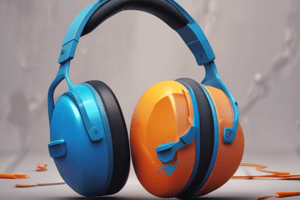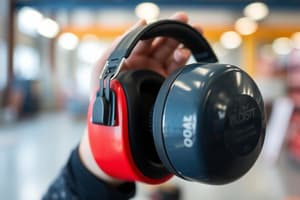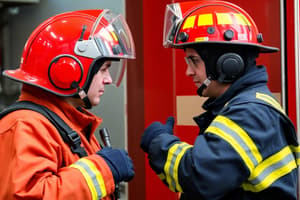Podcast
Questions and Answers
What is occupational noise and what is the minimum duration of exposure to be considered hazardous?
What is occupational noise and what is the minimum duration of exposure to be considered hazardous?
Occupational noise is noise exposure that occurs in the workplace, exceeding 85 decibels (dB) and lasting for 8 hours or more.
What are the two main effects of occupational noise exposure?
What are the two main effects of occupational noise exposure?
Permanent hearing loss and tinnitus (ringing in the ears)
What is the primary importance of wearing hearing protection in the workplace?
What is the primary importance of wearing hearing protection in the workplace?
Prevents hearing loss and tinnitus, reduces noise exposure, and enhances communication and productivity.
What are the three main types of hearing protection devices?
What are the three main types of hearing protection devices?
What is the Noise Reduction Rating (NRR) and what does it indicate?
What is the Noise Reduction Rating (NRR) and what does it indicate?
What is the main requirement of OSHA regulations regarding occupational noise?
What is the main requirement of OSHA regulations regarding occupational noise?
What is the recommended limit for noise exposure according to NIOSH guidelines?
What is the recommended limit for noise exposure according to NIOSH guidelines?
What is the recommended NRR for hearing protectors in environments with noise levels above 100 dB?
What is the recommended NRR for hearing protectors in environments with noise levels above 100 dB?
Flashcards are hidden until you start studying
Study Notes
Occupational Noise
- Definition: Noise exposure that occurs in the workplace, exceeding 85 decibels (dB) and lasting for 8 hours or more
- Sources:
- Machinery and equipment
- Power tools and hand tools
- Construction and demolition
- Music and entertainment
- Effects:
- Permanent hearing loss (sensorineural)
- Tinnitus (ringing in the ears)
- Decreased productivity and communication
Hearing Protection
- Importance:
- Prevents hearing loss and tinnitus
- Reduces noise exposure
- Enhances communication and productivity
- Types:
- Earplugs:
- Disposable or custom-made
- Reduce noise by 15-30 dB
- Earmuffs:
- Cover the entire ear
- Reduce noise by 20-30 dB
- Hearing Protectors with Communication:
- Allow for communication while maintaining noise protection
- Examples: earplugs with speakers, hearing protectors with radios
- Earplugs:
Noise Reduction Rating (NRR)
- Definition: A rating system that indicates the amount of noise reduction provided by a hearing protector
- Calculation: Based on the difference between the noise level and the noise level after wearing the protector
- Importance: Helps select the appropriate hearing protector for the specific noise environment
Regulations and Guidelines
- OSHA (Occupational Safety and Health Administration) regulations:
- Require employers to implement a hearing conservation program when noise exposure exceeds 85 dB
- Mandate regular audiometric testing and training for employees
- NIOSH (National Institute for Occupational Safety and Health) guidelines:
- Recommend limiting noise exposure to 85 dB or less for 8 hours
- Suggest using hearing protectors with an NRR of 22 or higher for noise levels above 100 dB
Occupational Noise
- Occupational noise is excessive noise exposure in the workplace, exceeding 85 decibels (dB) and lasting for 8 hours or more
- Sources of occupational noise include machinery and equipment, power tools and hand tools, construction and demolition, and music and entertainment
- Effects of occupational noise include permanent hearing loss (sensorineural), tinnitus (ringing in the ears), and decreased productivity and communication
Hearing Protection
- Hearing protection is crucial to prevent hearing loss and tinnitus, reduce noise exposure, and enhance communication and productivity
- Types of hearing protection include earplugs, earmuffs, and hearing protectors with communication
- Earplugs can be disposable or custom-made and reduce noise by 15-30 dB
- Earmuffs cover the entire ear and reduce noise by 20-30 dB
- Hearing protectors with communication allow for communication while maintaining noise protection, examples include earplugs with speakers and hearing protectors with radios
Noise Reduction Rating (NRR)
- NRR is a rating system that indicates the amount of noise reduction provided by a hearing protector
- NRR is calculated based on the difference between the noise level and the noise level after wearing the protector
- NRR is important for selecting the appropriate hearing protector for the specific noise environment
Regulations and Guidelines
- OSHA regulations require employers to implement a hearing conservation program when noise exposure exceeds 85 dB
- OSHA regulations mandate regular audiometric testing and training for employees
- NIOSH guidelines recommend limiting noise exposure to 85 dB or less for 8 hours
- NIOSH guidelines suggest using hearing protectors with an NRR of 22 or higher for noise levels above 100 dB
Studying That Suits You
Use AI to generate personalized quizzes and flashcards to suit your learning preferences.




